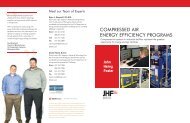The Turbo Air® 3000 Centrifugal Compressor Compressor Handbook
The Turbo Air® 3000 Centrifugal Compressor Compressor Handbook
The Turbo Air® 3000 Centrifugal Compressor Compressor Handbook
You also want an ePaper? Increase the reach of your titles
YUMPU automatically turns print PDFs into web optimized ePapers that Google loves.
<strong>The</strong> <strong>Turbo</strong> Air <strong>3000</strong> <strong>Centrifugal</strong> <strong>Compressor</strong> Operator’s Manual<br />
<strong>The</strong> Inspection Prior to Initial Startup Schedule<br />
As part of the site evaluation, a factory trained and authorized Cooper <strong>Turbo</strong>compressor service<br />
representative will verify that the compressor is ready to be put into full operation. <strong>The</strong> service representative<br />
will perform the following inspections and tasks as part of the initial compressor startup<br />
service.<br />
1. Check the compressor package for possible transit or handling damage.<br />
2. Inspect the compressor installation site, including other supporting air system equipment.<br />
3. Verify that the discharge air piping complies with Cooper <strong>Turbo</strong>compressor design requirements as<br />
stated in this manual as well as on the contract-specific drawings supplied separately. (This includes<br />
checking the locations of control valves, the inclusion of a system block valve, compressor flange<br />
load limits, etc.).<br />
4. Verify that the inlet air piping complies with Cooper <strong>Turbo</strong>compressor design requirements as<br />
stated in this manual and on contract-specific drawings supplied separately. (This includes checking<br />
the location of the inlet air filter/silencer, the position of the inlet air startup screen, compressor<br />
flange load limits, etc.)<br />
5. Inspect the water and condensate drain piping for completeness.<br />
6. Verify that all electrical connections have been made correctly.<br />
7. Verify that the compressor oil reservoir is filled with <strong>Turbo</strong>Blend TM Lubricating Oil.<br />
8. Rotate the compressor bullgear and main drive motor shaft (while uncoupled) by hand to verify<br />
that both rotate freely.<br />
9. Check the rotation of the main drive and oil pump motors.<br />
10. Make the final alignment of the motor shaft to the compressor shaft, doweling the motor in place<br />
when complete.<br />
11. Verify that the oil reservoir venting system is receiving the proper dry air supply.<br />
12. Begin the lubrication system flush procedure.<br />
13. Verify the temperature setting of the oil heater option (if included).<br />
14. Make any necessary Vantage Control System adjustments to satisfy the user’s expected requirements.<br />
15. Inspect the oil filter element and change it, if necessary.<br />
16. Oversee the installation of the main drive coupling, the lubrication of the coupling, and installation<br />
of the coupling guard.<br />
17. Complete the Pre-Startup Inspection Checklist shown in Table A—2 with installation personnel<br />
before the initial compressor startup procedure.<br />
A—38



